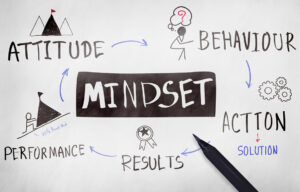 When it comes to performance and wellbeing, mindset has a tremendous impact. Mindset is also something that we have far more control over than, for example, external circumstances or the actions of others.
When it comes to performance and wellbeing, mindset has a tremendous impact. Mindset is also something that we have far more control over than, for example, external circumstances or the actions of others.
We are far more likely to be able to connect and communicate well with ourselves and others when our mind is at peace. Learning to shift from negative self-talk to positive, supportive thoughts helps to generate successful outcomes, achieve goals, and experience greater quality of life. All of these contribute to an overall life of greater peace and wellbeing.
What is Mindset?
The definition of mindset, according to the Merriam-Webster Dictionary, includes the following:
- A mental attitude, inclination, tendency or habit
- A particular way of thinking
- A person’s set of opinions about something
Think of a time when you felt completely empowered, engaged, and effective. Maybe you came up with a creative solution to a difficult problem, led your team through a successful strategy session, or negotiated a peace treaty between your teenagers at home.
Reflection Point: What was your mindset in that moment? What attitudes or opinions were you most focused on that created the experience and positive outcome?
If we focus on what’s wrong in a situation, seek to blame ourselves or others, or are unable to see a possible positive outcome, we are most likely viewing it through the lens of a negative mindset.
Mindset as the Path to Freedom
After being widowed at a young age, I found myself trapped in a negative mindset constructed of thoughts such as ‘why me’. I felt victimized by my situation, stuck in the story of what had happened. Then I read, Man’s Search for Meaning by Viktor Frankl. Frankl was a psychotherapist who had been imprisoned by the Nazi’s in a death camp. Though he was physically incarcerated with almost every freedom taken from him, Frankl discovered a sense of control through mindset.
The last of the human freedoms: to choose one’s attitude in any given set of circumstances, to choose one’s own way.(1)
Frankl recognized that we can’t necessarily control the situations and circumstances of our life. What he saw, instead, was an opportunity for personal growth by choosing how to respond to those circumstances.
Frankl’s story inspired me to examine my mindset. My response to being widowed was understandable and natural but it wasn’t empowering or supportive. I had a choice to make. I could continue to suffer or I could ask myself how I could grow from the experience and do something meaningful with the life I’d been given. By shifting my focus to what’s possible now, given that I can’t change what happened, I cleared out the mental clutter, lack of clarity, and the feelings of overwhelm.
Reflection Point: What about Frankl’s story and insights inspires you?
Shifting Your Mindset
How do you know if your mindset is positive or negative? Assess the degree to which you are:
- Clear
- Present
- Focused
- Decisive
When you feel confused, overwhelmed, indecisive, or unable to focus on the task or matter at hand, you are most likely looking at the situation through a more negative mindset. When you are mentally clear, you are more alert. You’ll find you’re more able to tap into being flexible and coming up with creative solutions.
There is a significant difference between ‘thinking happy thoughts’ and creating a positive mindset. When working on mindset shifts, we are not ignoring that we may be experiencing challenging or difficult circumstances. Instead,
- Acknowledge the negative thoughts. Be mindful, however, not to judge yourself for having them.
- Identify your options. Recognize you can choose to feel overwhelmed, upset, or limited by this challenge or you can choose to see it as an opportunity to learn and grow.
- Assess the pain. Notice what the negative mindset is costing you. Where is it creating tension or stress in your life? How is it limiting your happiness and your success?
- Discover the possibilities. What is a different way to look at the situation? If you can’t travel down the road on your left, instead of standing still at a crossroads, what might be possible by choosing to go down the road on the right – even if it isn’t what you’d planned or expected?
There are many ways to move from a negative mindset to a positive one. You can experiment with:
- Journaling
- Meditating
- Listening to music that lifts your spirits
- Volunteering to help others
- Walking in nature
- Spending time with a beloved pet or a positive minded person
- Working with a therapist or a coach
These are all excellent strategies that can also work to reduce tension and increase flow. However, there is also much to be said about the power of simply choosing to look at something in a different way. Right now, in this moment, simply choose to reframe any negative thoughts into positive ones.
Reflection Point: What’s one negative thought you could choose to change right now in this moment?
Stay tuned for part four of this blog series where we focus on moving From Tension to Flow: In Relationships.
[1] Frankl, Dr. Viktor, Man’s Search for Meaning, Simon & Schuster, 1959, Page 86
